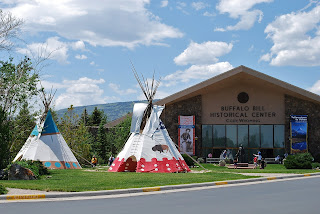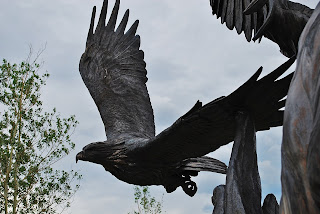As William F. Cody neared the end of his life, the things that he loved doing most were the same things he had enjoyed during youth - camping, horseback-riding, hunting, guiding, tending cattle, and spending time outdoors.
In northwest Wyoming, near Yellowstone National Park, he helped found the town that stills bears his name, and thus helped achieve his vision of creating a gateway for visitors worldwide to come and experience the still-wild West. Today, the man of the West continues to bring the world to the West, even as he did in his time.
In Cody, Wyoming, the Buffalo Bill Historical Center certainly helps one to learn much about this now-famous man. But it also has quality, in-depth exhibits on other western subjects - the plains tribes, arts, culture, firearms, and natural history.
Buffalo Bill - Plainsman
Bob Scriver
At the main entrance, you are greeted by this bronze sculpture depicting Buffalo Bill as a western hero and gentleman, wearing his Wild West show attire and holding a rifle.
Born in 1846 in a little town on the Mississippi River, Bill Cody, much as others of his day, acquired invaluable practical skills. He refined these and worked in a diverse range of occupations - as a teamster, Pony Express rider, wagon master, guide, soldier and cavalryman, and as an Army scout. These experiences helped define his character and through living, working, and learning, he became - and remained - a man of the West.
Bill Cody- Hard and Fast All the Way
Peter Fillerup
This 12’ high, 2,000 pound statue pays tribute to the 150th Anniversary of the Pony Express, as well as to local legend, Bill Cody, who as boy rode for the firm of Russell, Majors and Waddell.
Although Cody's experiences were not unique, few others of his time matched him in the range and diversity of his experiences. As the Indian tribes mourned the loss of the vast herds of buffalo, it was his special prowess at hunting those very animals that earned him the now-famous nickname and vaulted him from relative obscurity to lasting fame.
In 1883, Cody and several associates introduced "Buffalo Bill's Wild West," an innovative traveling outdoor spectacle featuring cowboys and Indians, sharpshooters, wild animals, and dramatic re-creations of scenes of frontier life. Buffalo Bill became a living, breathing icon and embodiment of America's western experience—a larger-than-life figure whose exploits and stories about settling the West captivated millions, not only in North America but also through Europe and, from there, to the rest of the world. Buffalo Bill performed before royalty, was feted by heads of state, became an object of adulation, posed for countless portraits and gave innumerable interviews, and even sat for an audience with the pope in the Vatican. The man of the West had become a man of the world.
Buffalo Bill - The Scout
Gertrude Vanderbilt Whitney
As seen from inside the Center, this monumental tribute to Buffalo Bill, dedicated in 1924, depicts the western figure as an army scout, peering down a trail signaling troops to follow.
Last of the Buffalo
Michael Coleman
The subject of much ancient lore throughout the world, and specifically in North American Indian tribes, the wolf is a symbol of the wildness of the West. Although an important part of the ecosystem for eons, today his presence causes mixed feelings. While many wildlife enthusiasts appreciate wolves, some ranchers feel at risk of losing livestock by preying packs.
Daddy Long Legs
T.D. Kelsey
This sculptor captured the animated and sometimes awkward movements of an adult moose. Here is an animal quite unlike any other - to be tittered at, respected, and admired - but always from a safe distance!
Prickly Pear
Charles Ringer
A drought-tolerant species, the nasty, yet beautiful, Prickly Pear cactus is common throughout the West. This imaginative steel sculptor found his inspiration for this sculpture in the Beartooth Mountains of Montana, not far from Cody. Originally made of shiny polished steel, the piece was exposed in the outdoors to rust into a warm red color.
Just down the street from the Center, we found the Mountain Trails Galleries with some more fabulous western sculptures:
Texas Two Step
Vic Payne
According to the sculptor: "This Texas cowpuncher has found himself in a heap of trouble and if the game warden chanced upon this scene today, it’d be a whole lot worse. A little Texas spirit was just enough to give this cowboy the idea to rope a whitetail buck that had been eluding him the past few hunting seasons. When the cowboy threw the lasso, the big Texas buck was none too happy, then those bobwhites blew up and the real rodeo began. Next time you see a cowboy, lariat at the ready, you might think about this old cowboy and his ‘Texas Two-step’."
Where Eagles Dare
Vic Payne
A mama bear is certainly nothing to fool with and if she happens to be a grizzly, all the more reason to steer clear.
These eagles are taking her on, though, and one certainly might wonder why.
The reason, of course, lies neatly tucked away in the bottom of the sculpture....
...then it becomes quite clear ...
Someone's young will eat today...
Someone's will go hungry - that is the way of the wild.
For more information on the Buffalo Bill Historical Center:
Mountain Trails Galleries


















No comments:
Post a Comment